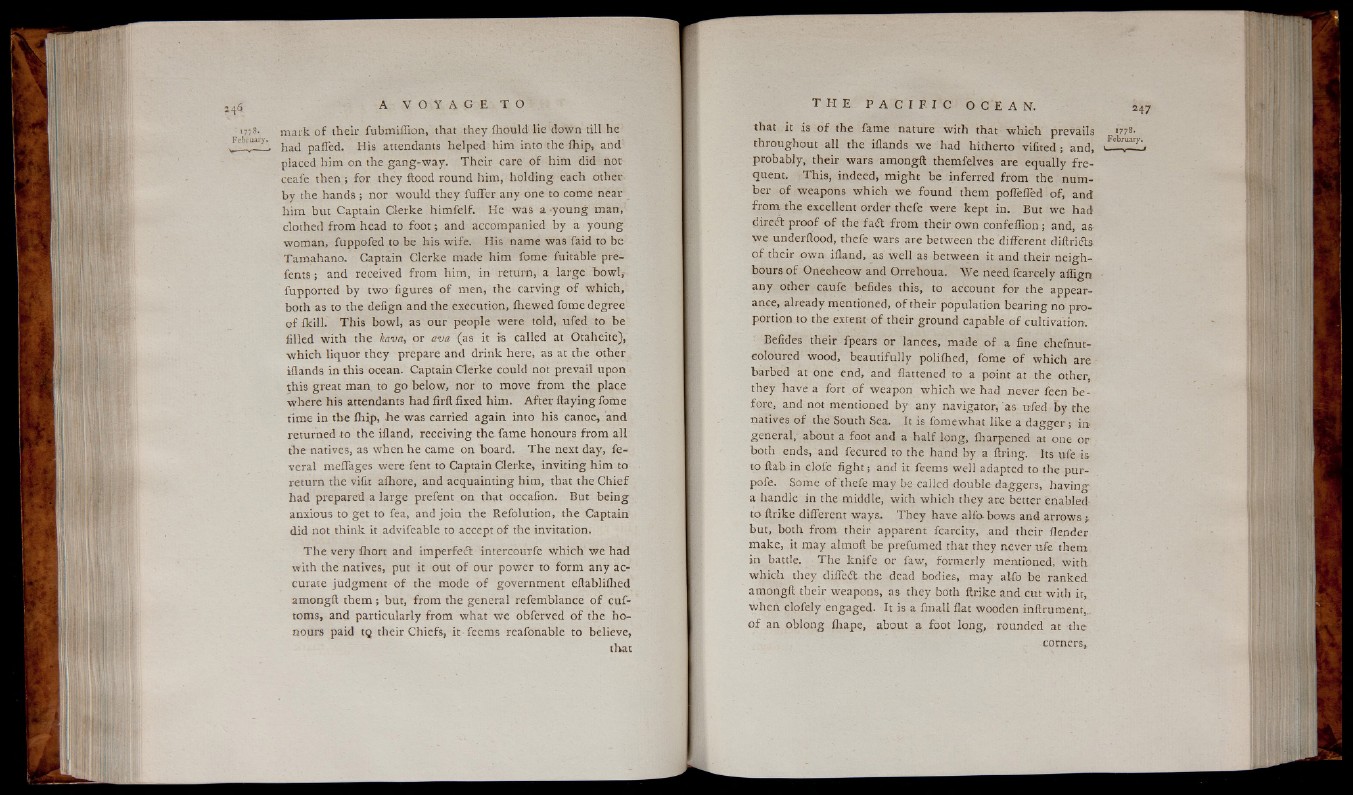
mark o f their fubmiffion, that they ihould lie down till he
had paffed. His attendants helped him into the ihip, and
placed him on the g an g -w a y . T h e ir care o f him did not
ceafe then ; for they flood round him, holding each other
b y the hands ; nor would they fuffer any one to come near
h im but Captain Clerke himfe lf. He was a yo u n g man,
clothed from head to f o o t ; and accompanied by a you n g
woman, fuppofed to be his wife . His name was faid to be
T am ah an a Captain Clerke made him fome luitable pre-
fe n t s ; and received from him, in return, a large howl,
fupported b y two figures o f men, the carving o f which,
both as to the defign and the execution, ihewed fome degree
o f Ikill. T his bowl, as our people were told, ufed to be
filled with the kava, or ava (as it is called at Otaheite),
w h ich liquor they prepare and drink here, as at the other
iflands in this ocean. Captain Clerke could not prevail upon
this great man, to g o below, nor to move from the place
where his attendants had firft fixed him. After flayin g fome
time in the Ihip, h e was carried again into his canoe, and
returned to the ifland, receiving the fame honours from all
the natives, as when he came on board. T h e next day, fe-
veral meffages were fent to Captain Clerke, in viting him to
return the vifit alhore, and acquainting him, that the C h ie f
had prepared a la rge prefent on that occafion. But being
anxious to get to fea, and jo in the Refolution, the Captain
did not think it advifeable to accept o f the invitation.
T h e ve ry lhort and imperfeit intercourfe w hich w e had
with the natives, put it out o f our power to form any accurate
judgment o f the mode o f government eftablilhed
amongft th em ; but, from the general refemblance o f cuf-
toms, and particularly from what we obferved o f the honours
paid tq their Chiefs, it feems reafonable to believe,
that
that it is o f the fame nature with that w h ich prevails 17/8-
throughout all the iflands we had hitherto vifited 5 and,
probably, their wars amongft themfelves are equally f r e quent.
This, indeed, m igh t be inferred from the number
o f weapons w hich we- found them poffeffed of, and
from the excellent order thefe were kept in. But we had
direft proof o f the fa i t from their own con fe flion ; and, as
we underftood, thefe wars are between the different diftrids
o f their own ifland, as well as between it and their n eighbours
o f Oneeheow and Orrehoua. We need fcarcely aflign
any other Caufe befides this, to account for the appearance,
already mentioned, o f their population bearing no proportion
to the extent o f their ground capable o f cultivation.
Befides their fpears or lances, made o f a fine chefnut-
eoloured wood, beautifully poliflied, fome o f w hich are
barbed at one end, and flattened to a point at the other,
they have a fort o f weapon which we had never feen b e fore,
and not mentioned by any navigator, as trfed by the
natives o f the South Sea. It is fomewhat lik e a dagg er ; in*
general, about a foot and a ha lf long, fliarpened at one or
both ends, and fecured to the hand by a firing. Its ufe is
to flab in clofe f ig h t ; and it feems well adapted to the pur-
pofe. Some o f thefe may be called double daggers, having
a handle in the middle, with which they are better enabled
to flrike different w ays. T h e y have alfo- bows and arrows 5.
but, both from their apparent fcarcity, and their flender
make, it may almoft be prefumed that they never ufe them
in battle. T he kn ife or faw, formerly mentioned, w ith
which they d ified the dead bodies, may alfo be ranked
amongft their weapons, as they both ftrike and cut with it,
when clofely engaged. It is a fmall flat wooden inftrumenr,
o f an oblong fliape, about a foot long, rounded at the
corners,